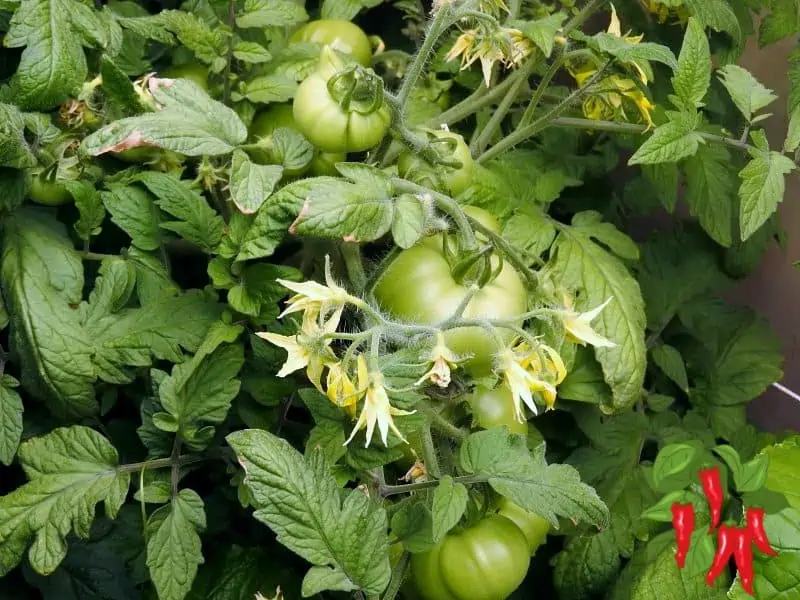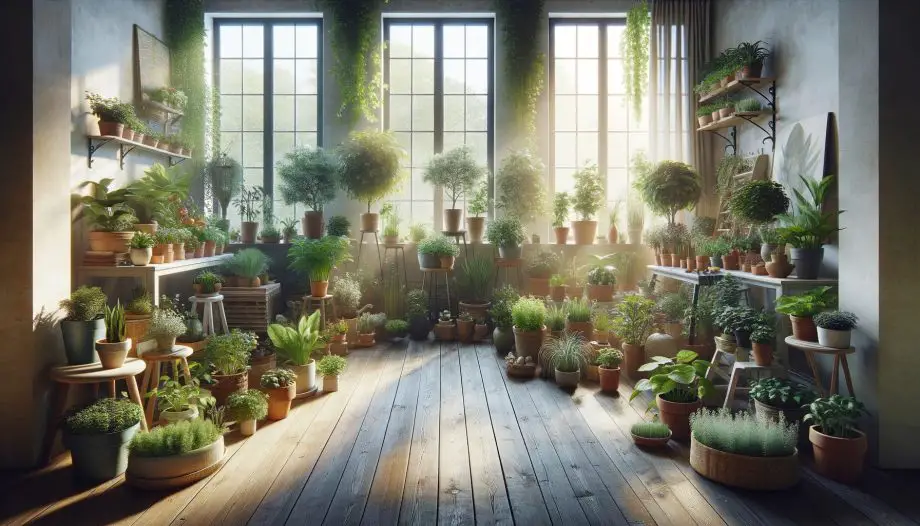This post may contain affiliate links. If you buy something from one of our links we may earn a commission. Thanks
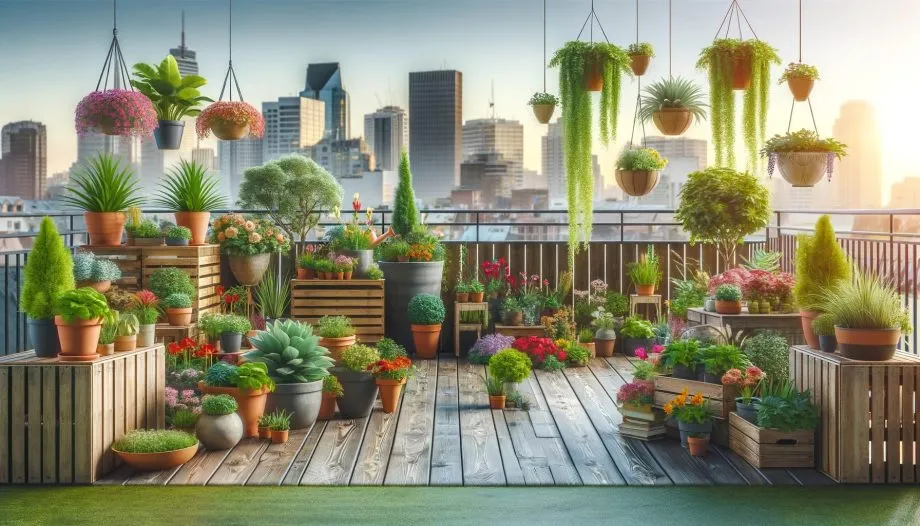
Explore rooftop container gardening ideas to transform your urban space. Discover tips and inspiration for your rooftop garden!
Rooftop Container Gardening Ideas
Key Takeaways:
- Rooftop container gardening ideas involve utilizing containers to grow plants on rooftops.
- This space-saving solution is perfect for urban areas with limited ground space.
- It allows for cultivating a variety of plants, from herbs and vegetables to ornamentals, in an elevated, controlled environment.
Welcome to the world of rooftop container gardening ideas!
Whether you’re an urban dweller with limited ground space or just looking to add some greenery to your rooftop, this guide is packed with creative tips and inspiring ideas to help you cultivate a stunning garden in the sky.
Let’s turn that unused roof space into a thriving green retreat!
I. What Are Rooftop Container Gardening Ideas?

Rooftop container gardening is a creative and efficient way to bring greenery to urban spaces.
They offer a practical solution for those who lack ground-level gardening space or live in buildings with rooftop weight restrictions.
In this post, we’ll explore cost-effective rooftop container garden ideas, DIY tips, and the best plants for rooftop gardening.
Whether you’re a seasoned gardener or a beginner, these ideas will help you transform your rooftop into a flourishing green oasis.
Rooftop container gardening is an innovative and practical approach for urban spaces, especially for buildings that cannot support traditional intensive or extensive roof gardens due to weight limitations.
You can can transform a flat, tar roof into a lovely outdoor haven with container plantings. A well-planned rooftop garden can also provide habitat for local wildlife and mitigate storm-water runoff. BBG
Here are some key considerations and ideas for creating a thriving rooftop container garden:
I. Assessing Your Rooftop Space
Evaluating Your Roof for a Garden
Before starting your rooftop garden, it’s essential to assess your roof’s structural requirements and condition.
This initial step is crucial to ensure that your rooftop can safely support a garden.
We’ll discuss how to evaluate the strength of your roof, understand its limitations, and prepare it for a container garden in the next section.
II. Assessing Your Rooftop Garden Space
Understanding Your Roof’s Capability
The first step in creating a rooftop container garden is to assess your roof’s condition and suitability.
It’s not just about having space; it’s crucial to ensure your roof can safely support the garden’s weight and provide the right conditions for plant growth.
In this section, we’ll explore how to evaluate your roof’s structural integrity, sun exposure, and heat conditions, laying the groundwork for a successful rooftop garden.
Evaluating Roof Strength and Maintenance Needs:
Before you place even a single pot, it’s important to understand your roof’s structural requirements.
- This involves checking the roof’s load-bearing capacity to ensure it can handle the weight of soil, containers, and plants.
- Remember, water adds weight too, especially after rain.
- It’s also crucial to consider any upcoming maintenance needs.
- The last thing you want is to set up a beautiful garden only to move everything for roof repairs.
Sunlight and Heat Exposure Assessment:
Most rooftop gardens get plenty of sun, which is great for sun-loving plants but challenging for those that require shade.
• Observe your roof throughout the day to understand its sun exposure pattern. Does it get full sun, partial shade, or full shade?
• This will determine the type of plants you can grow.
• Also, consider the color of your roof; darker roofs absorb more heat, which could affect plant health and watering needs.
Water Supply and Drainage Solutions:
An essential aspect of rooftop gardening is ensuring a reliable water source.
- Daily watering might be needed, and setting up a convenient watering system, like a drip irrigation system, can save a lot of effort.
- Also, think about drainage. Proper drainage is vital to prevent waterlogging and protect the roof’s structure.
- Ensure your containers have adequate drainage holes, and consider placing them on raised platforms or using drainage mats.
Managing Wind and Extreme Weather:
Rooftops are more exposed to the elements, especially wind. This can dry out plants quickly and damage or topple tall plants and lightweight containers.
Plan for wind by choosing low-profile, heavy containers or using windbreaks like trellises.
Additionally, think about how you’ll protect your plants from extreme weather conditions like heavy rain or snow.
Accessibility and Safety Considerations:
Lastly, consider how you’ll access your rooftop garden.
- Is it easy to get to for regular maintenance?
- Do you have a safe way to transport water, soil, and plants up and down?
- Also, consider any safety measures needed, especially if you have pets or children.
III. Choosing the Right Plants
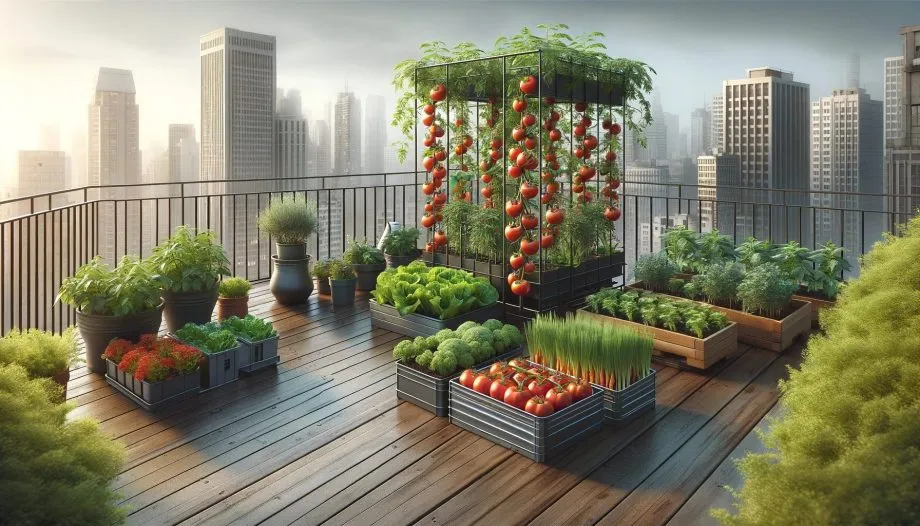
Selecting Resilient Plants for Your Rooftop Garden
The success of a rooftop container garden largely depends on choosing plants that can thrive in its unique environment.
Rooftop conditions like intense sun, fluctuating temperatures, strong winds, and limited soil depth present a unique set of challenges.
In this section, we’ll highlight plants that not only endure but flourish in these conditions, making your rooftop garden both beautiful and resilient.
Succulents and Cacti for Heat and Sun:
- If your rooftop gets a lot of sun and heats up significantly, succulents and cacti are excellent choices.
- These plants are adapted to survive in harsh, sunny environments.
- Options like Aloe Vera, Sedums, Sempervivum (Hens and Chicks), and various types of Echeveria offer not only drought resistance but also add interesting textures and forms to your garden.
Hardy Herbs and Perennials for Sun and Wind:
- Herbs like Rosemary, Thyme, and Lavender are not just aromatic and useful for cooking; they’re also tough enough to withstand windy conditions.
- Perennials such as Coneflowers, Butterfly Weed, and Agastache are great for adding color and attracting pollinators while being robust enough for rooftop conditions.
Evergreens for Year-Round Interest:
- Plants like Junipers, Dwarf Pines, and Boxwoods can provide greenery throughout the year.
- These evergreens are often drought tolerant and can add structure and permanence to your garden.
Cool Season Vegetables and Leafy Greens:
- If you’re interested in growing edibles, cool-season vegetables like lettuce, spinach, and radishes can be a good choice.
- They can tolerate cooler temperatures and can be grown in both spring and fall.
Flowering Annuals for Color:
- For seasonal color, consider annuals like Petunias, Marigolds, and Pansies.
- While they might need more frequent watering and care, they can brighten up your rooftop space beautifully.
Lightweight and Wind-Resistant Trees and Shrubs:
- Consider smaller, lightweight trees and shrubs that can handle the rooftop environment.
- Species like Dwarf Citrus Trees, Olive Trees, and certain varieties of small Maples can add height and visual interest without overloading the roof’s weight capacity.
Grasses for Texture and Movement:
- Ornamental grasses such as Blue Fescue, Pennisetum, and Miscanthus add texture and movement to your garden.
- They can also act as a natural windbreak, protecting more delicate plants.
Native Plants for Local Adaptation:
- Don’t forget to consider native plants. They are often well-adapted to the local climate and can be more resilient and require less maintenance.
Remember, the key to a successful rooftop container garden is choosing plants that match the environmental conditions of your rooftop.
This ensures not only the health and growth of the plants but also reduces the need for constant care and maintenance.
Table: Choosing the Right Plants
| Type of Plant | Characteristics | Examples |
|---|---|---|
| Succulents and Cacti | Drought-tolerant, love sun | Aloe Vera, Echeveria, Sedum |
| Hardy Herbs | Wind-resistant, aromatic | Rosemary, Thyme, Lavender |
| Evergreens | Year-round greenery | Junipers, Dwarf Pines |
| Cool Season Veggies | Tolerate cooler temps | Lettuce, Spinach, Radishes |
| Flowering Annuals | Seasonal color | Petunias, Marigolds |
| Lightweight Trees | Suitable for containers | Dwarf Citrus, Olive Trees |
| Ornamental Grasses | Add texture and movement | Blue Fescue, Pennisetum |
| Native Plants | Adapted to local climate | Varies by region |
IV. Soil and Watering Needs
Balancing Moisture for a Thriving Rooftop Garden
The health of your rooftop garden hinges on getting two key elements right: soil and water.
Rooftop conditions like intense sun and wind make this especially important.
Let’s dive into how you can ensure your garden has the perfect soil and stays well-watered.
Selecting the Ideal Soil Mix:
-
- Use a mix of potting soil, compost, and perlite for balance.
- This combination allows for good drainage and moisture retention.
Enhancing Drainage and Aeration:
-
- Add perlite or vermiculite to improve soil drainage.
- Ensure containers have enough drainage holes.
Effective Watering Techniques:
-
- Water more frequently during hot, windy conditions.
- Check soil moisture regularly – water when the top inch is dry.
Utilizing Mulch:
-
- Apply organic mulch to conserve moisture and cool roots.
- Options include straw, bark chips, or coco coir.
Implementing Drip Irrigation:
-
- Consider a drip irrigation system for consistent watering.
- Ideal for maintaining moisture with minimal effort.
Countering Wind and Heat:
-
- Water early morning or late afternoon to reduce evaporation.
- Increase watering frequency in full sun locations.
Monitoring Plant Health:
-
- Look for signs of stress like wilting or yellowing.
- Adjust watering based on plant needs and weather changes.
IV. Soil and Watering Needs
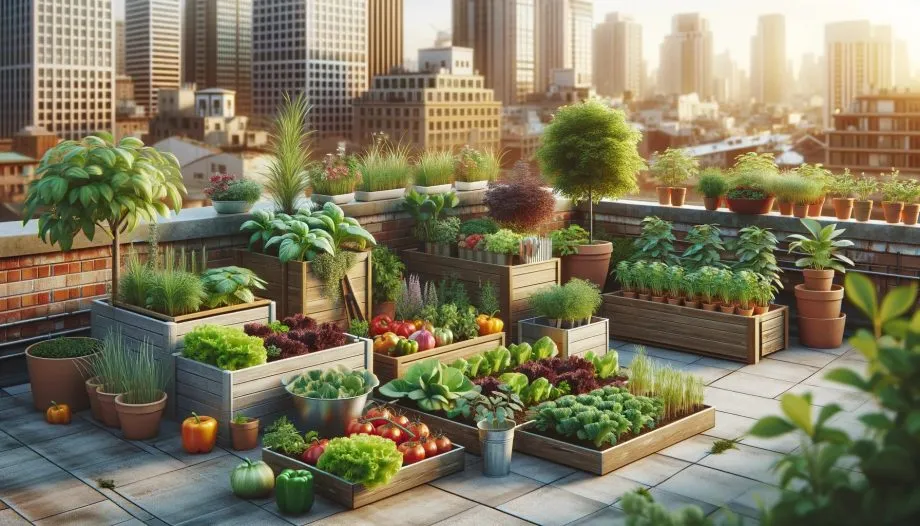
Ensuring Healthy Growth with the Right Soil and Water
One of the most crucial aspects of rooftop container gardening is choosing the right soil and maintaining proper watering practices.
Given the unique conditions of rooftop environments, such as increased wind exposure and radiant heat, understanding the soil and watering needs is key to a thriving garden.
In this section, we’ll delve into the importance of using well-draining, moisture-retentive soil, and provide practical watering tips tailored for rooftop gardens.
Choosing the Right Soil Mix:
Rooftop container gardens need soil that drains well yet retains enough moisture to support plant health.
A mix of coco coir or potting soil with compost, and perlite is often effective in achieving this balance.
This combination allows for adequate drainage, preventing waterlogged roots, while also holding enough moisture to sustain plants through hot, windy days.
Improving Drainage and Aeration:
Proper drainage is vital to prevent root rot and fungal diseases.
Consider adding materials like perlite or vermiculite to your soil mix to enhance aeration and drainage.
Also, ensure your containers have sufficient drainage holes.
Elevating pots slightly off the ground can further improve drainage and prevent staining or damage to the rooftop surface.
Watering Strategies for Rooftop Conditions:
Rooftop gardens can dry out quickly due to wind and sun exposure. Frequent watering may be necessary, especially during hot spells.
However, be mindful not to overwater. Check the soil moisture regularly. If the top inch of soil is dry, it’s time to water.
Using a watering can or hose with a gentle spray setting can prevent soil erosion and ensure even watering.
Using Mulch to Retain Moisture:
Applying a layer of organic mulch on the soil surface can help retain moisture, reduce weed growth, and keep the roots cool.
Options like straw, bark chips, or coco coir not only conserve water but also add an aesthetic touch to your containers.
Drip Irrigation and Automated Systems:
For those who can’t water daily, consider installing a drip irrigation system.
It delivers water directly to the roots, minimizes evaporation, and can be automated for consistent watering, even when you’re not around.
Dealing with Wind and Heat Exposure:
Wind can rapidly increase evaporation, drying out plants quickly.
In such cases, watering in the early morning or late afternoon when temperatures are cooler can be more effective.
For plants in full sun, consider watering more frequently to counteract the effects of intense heat.
Monitoring Plant Health and Adjusting Accordingly:
Always observe your plants for signs of stress, such as wilting or yellowing leaves, which can indicate over or under-watering.
Adjust your watering routine based on the specific needs of your plants and the changing rooftop conditions.
V. Selecting Suitable Containers
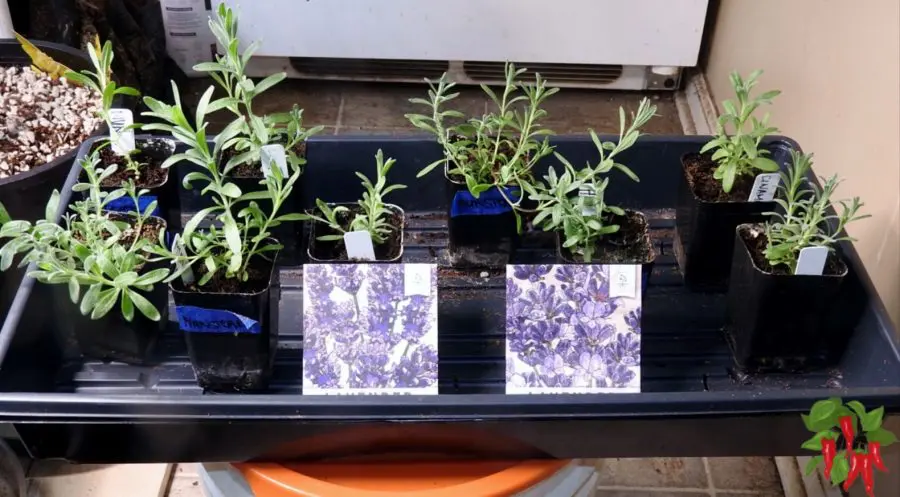
The Art of Choosing the Right Containers
Containers are more than just plant holders in a rooftop garden; they’re crucial elements that affect the health of your plants and the overall aesthetic of your space.
Given rooftop conditions and weight limitations, selecting the right type of container is vital.
In this section, we’ll discuss why choosing lightweight yet sturdy containers is important and offer creative ideas for container options.
Importance of Lightweight Containers:
-
- Ensures compliance with rooftop weight limitations.
- Easier to move and rearrange for design flexibility.
Materials to Consider:
-
- Opt for materials like fiberglass, plastic, or resin.
- These materials offer durability without adding excess weight.
Repurposed Items as Containers:
-
- Old buckets, wooden crates, or even metal tubs can be repurposed.
- They add a unique, personalized touch to your garden.
Using Hanging Baskets:
-
- Great for trailing plants like ivy or petunias.
- Helps to utilize vertical space effectively.
Creative Container Ideas:
-
- Consider colorful metal pails for a whimsical look.
- Use large ceramic pots for a statement piece.
Ensuring Adequate Drainage:
-
- Regardless of the container type, ensure good drainage.
- Drill holes in repurposed containers if needed.
Considerations for Weight Distribution:
-
- Distribute heavier containers evenly across the rooftop.
- Avoid clustering too much weight in one area.
Balancing Aesthetics and Functionality:
-
- Choose containers that complement your rooftop’s style.
- Ensure they are functional for the types of plants you are growing.
Table: Selecting Suitable Containers
| Container Type | Benefits | Ideal Plants |
|---|---|---|
| Fiberglass/Plastic | Lightweight, durable | Most plant types |
| Repurposed Items | Unique, eco-friendly | Herbs, succulents |
| Hanging Baskets | Space-saving | Trailing plants |
| Metal Troughs | Rustic look | Grasses, flowers |
| Ceramic Pots | Aesthetic appeal | Small shrubs, trees |
| Wooden Crates | Natural look | Vegetables, flowers |
VI. Adhering to Building Codes and Regulations
Navigating Legalities for a Safe Rooftop Garden
When creating a rooftop garden, it’s not just about aesthetics and horticulture.
Adhering to local building codes and regulations is a crucial aspect that ensures the safety and legality of your rooftop oasis.
In this section, we’ll emphasize the importance of understanding and complying with these regulations, including weight limitations and safety measures.
Understanding Local Building Codes:
-
- Investigate city-specific regulations regarding rooftop usage.
- These codes often outline weight limits, safety barriers, and other structural requirements.
Importance of Weight Limitations:
-
- Rooftops have specific load-bearing capacities.
- Overloading can lead to structural damage or even collapse.
Ensuring Safety Measures:
-
- Safety measures may include railings or barriers around the garden.
- These are crucial to prevent accidents, especially in high-rise buildings.
Consulting with Professionals:
-
- Consider hiring a structural engineer or architect.
- They can provide expert advice on your rooftop’s capacity and safe garden installation.
Regular Maintenance and Inspections:
-
- Regular checks to ensure the garden remains compliant and safe.
- Address any wear and tear or structural issues promptly.
Securing Necessary Permits:
-
- Some cities require permits for rooftop modifications.
- Obtain all necessary approvals before starting your garden project.
Respecting Neighbors and Community:
-
- Be mindful of how your garden affects neighbors.
- Ensure it doesn’t block views, create excess water runoff, or violate privacy.
Adapting to Changing Regulations:
-
- Stay informed about any changes in local regulations.
- Ensure your rooftop garden continues to comply with new rules.
Complying with local building codes and regulations is fundamental for creating a rooftop garden that is not only beautiful but also safe and legal.
VII. Designing the Rooftop Garden Layout
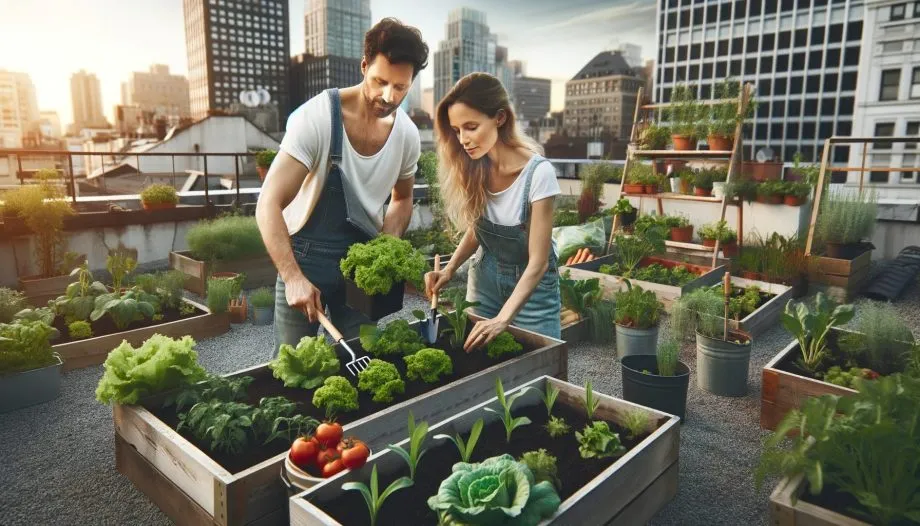
Crafting Your Rooftop Garden Masterpiece
Designing the layout of your rooftop garden is like painting a living canvas.
It’s not just about placing plants; it’s about creating a space that is both functional and aesthetically pleasing.
A well-planned layout maximizes space, defines different zones, and incorporates seating areas for relaxation.
Here, we’ll provide tips and ideas for arranging your rooftop garden to make the most of your urban retreat.
Maximizing Limited Space:
-
- Utilize vertical gardening techniques with wall planters and trellises.
- Consider multi-level plant stands to create layers and depth.
Creating Defined Zones:
-
- Designate areas for dining, lounging, and gardening.
- Use container arrangements or outdoor rugs to visually separate zones.
Incorporating Seating Areas:
-
- Add comfortable seating like benches, chairs, or even a hammock.
- Ensure seating is weather-resistant and complements the garden’s style.
Strategic Plant Arrangement:
-
- Group plants based on their sunlight and water needs.
- Arrange taller plants in the back and shorter ones in front for visual balance.
Adding Aesthetic Elements:
-
- Introduce pops of color with flowering plants or decorative containers.
- Include lighting for evening ambiance, like string lights or solar lanterns.
Functional Pathways:
-
- Create clear pathways for easy access and maintenance.
- Use stepping stones, decking, or gravel to define walkways.
Incorporating Edible Plants:
-
- Blend edible plants like herbs and vegetables with ornamentals for a functional yet beautiful layout.
- Raised beds or larger containers can be used for vegetable gardening.
Adapting to Rooftop Conditions:
-
- Position wind-sensitive plants in sheltered areas.
- Use hardy plants for exposed, windy corners.
Sustainability Considerations:
-
- Incorporate eco-friendly materials and native plants.
- Consider a small composting area for organic waste.
Designing your rooftop garden is an exciting process that combines creativity with practicality. The layout should not only be visually appealing but also cater to the unique conditions of a rooftop setting.
Table: Designing the Rooftop Garden Layout
| Design Element | Purpose | Tips/Suggestions |
|---|---|---|
| Vertical Gardening | Space maximization | Use wall planters, trellises |
| Zoning | Functional areas | Separate dining, lounging zones |
| Seating | Relaxation, enjoyment | Include weather-resistant chairs, benches |
| Plant Arrangement | Aesthetic appeal | Group by height, sunlight needs |
| Decorative Elements | Visual interest | Use colorful pots, garden art |
| Pathways | Accessibility | Implement stepping stones, decking |
These tables summarize key points in each section, providing a quick
VIII. Maintenance Tips
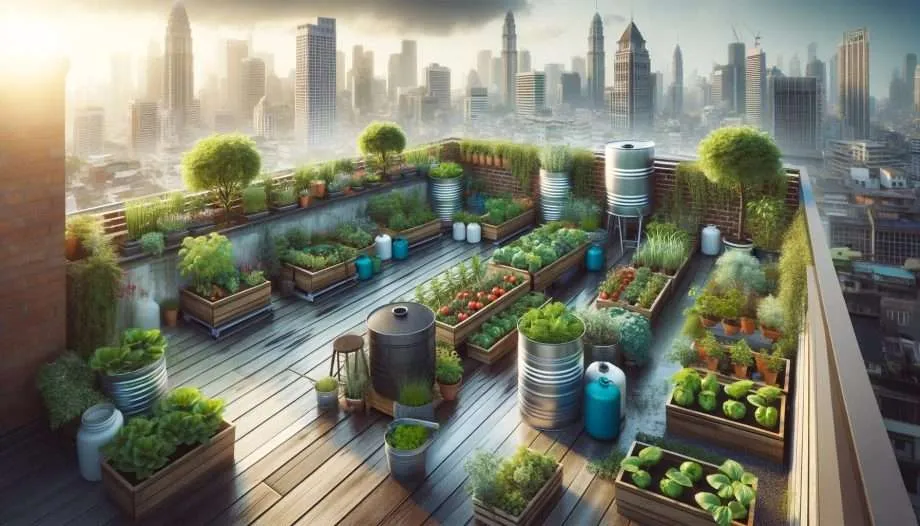
Keeping Your Rooftop Garden Flourishing
A rooftop garden, like any garden, requires regular care and maintenance to stay healthy and vibrant.
In this section, we’ll delve into essential maintenance tips for your rooftop oasis. From watering routines to fertilizing schedules and protecting your plants from harsh weather, these tips will help ensure your garden remains a lush and inviting space.
Watering Wisely:
-
- Water plants early in the morning or late in the evening to reduce evaporation.
- Use a watering can or hose with a gentle nozzle to avoid soil erosion.
Fertilizing for Growth:
-
- Apply a balanced, slow-release fertilizer to provide consistent nutrients.
- For edible plants, use organic fertilizers to ensure safe consumption.
Protecting from Extreme Weather:
-
- During hot spells, provide shade with cloth or temporary coverings.
- In windy conditions, secure lightweight pots and use windbreaks like trellises.
Pruning and Deadheading:
-
- Regularly prune overgrown branches and remove dead or yellowing leaves.
- Deadhead spent flowers to encourage new blooms.
Pest and Disease Management:
-
- Inspect plants regularly for signs of pests or diseases.
- Use natural pest control methods, like neem oil or insecticidal soap.
Soil and Root Care:
-
- Check the soil condition periodically and replenish as needed.
- Avoid compacting the soil around the roots, which can hinder growth.
Seasonal Adjustments:
-
- Adjust care routines based on the season – more watering in summer, less in winter.
- Consider seasonal replanting for year-round interest and variety.
Regular Cleaning and Upkeep:
-
- Keep the rooftop clean of fallen leaves and debris.
- Clean containers and tools to prevent disease spread.
Monitoring Plant Health:
-
- Watch for changes in plant color, texture, and growth patterns.
- Adjust care routines based on the plant’s specific needs and responses.
Regular maintenance is key to a thriving rooftop garden. Each plant has its unique needs, and adjusting your care routine accordingly can make a big difference.
Rooftop Container Gardening FAQs
Starting on a rooftop gardening adventure comes with its own set of questions and curiosities.
In this section, we address some frequently asked questions about rooftop container gardening, providing you with practical answers and tips to help you cultivate your rooftop paradise successfully.
Q: How much weight can my rooftop support for a garden?
A: The weight capacity varies based on the building’s design and structure.
It’s essential to consult with a structural engineer or your building management to determine the specific weight limitations of your rooftop.
Q: What are the best plants for a windy rooftop garden?
A: Wind-resistant plants like ornamental grasses, succulents, dwarf shrubs, and certain hardy perennials are great choices.
They can withstand the windy conditions typically found on rooftops.
Q: How can I ensure proper drainage in my rooftop containers?
A: Make sure your containers have adequate drainage holes. You can also improve drainage by adding a layer of gravel or broken pottery at the bottom of the pot and using a well-draining soil mix.
Q: Is it necessary to get a permit for a rooftop garden?
A: This depends on your location and the scale of your garden. Some cities require permits for significant modifications to rooftops.
Always check local regulations and building codes before starting your garden.
Q: Can I grow vegetables and herbs in my rooftop garden?
A: Absolutely! Many vegetables and herbs thrive in rooftop gardens. Just ensure they get the right amount of sunlight and water.
Herbs like basil, thyme, and rosemary, and vegetables like tomatoes, peppers, and leafy greens are popular choices.
Q: What are some low-maintenance plants for a rooftop garden?
A: Succulents, sedums, lavender, and certain grasses are low-maintenance options that are well-suited to the rooftop environment. They require minimal watering and care.
Q: How can I protect my rooftop plants from extreme weather?
A: Use planters that can be moved indoors or under shelter during harsh weather.
For plants that cannot be moved, consider protective coverings like garden cloths or temporary shades during heatwaves or frost.
Q: How often should I water my rooftop garden?
A: This varies based on climate, plant type, and weather conditions. Generally, check the soil moisture and water when the top inch feels dry.
During hot, dry periods, daily watering may be necessary.
Rooftop Container Gardening Ideas Conclusion
Visit my Amazon Influencer Page for videos and gardening products Grow Your Own Garden


